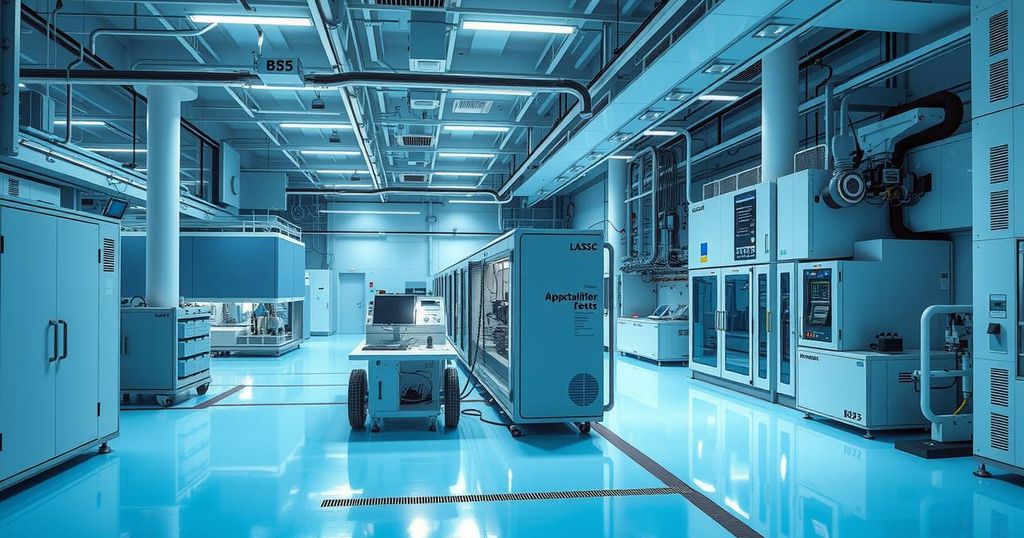Weekly News Roundup: Shifts in the Semiconductor Landscape

This week featured major developments in the tech and semiconductor sectors, emphasizing China’s lithography advancements, Samsung securing new contracts with Nintendo, and TSMC’s plans for new fabs. Alongside these, European lawmakers consider banning Chinese solar technology due to cybersecurity concerns. Key shifts in power dynamics were evident, impacting global semiconductor markets.
In the world of tech and semiconductors, the week from May 12 to May 18 revealed significant shifts, especially as China makes strides in lithography, Samsung wins major contracts, and TSMC expands its global operations. Notably, these developments reflect the dynamic power play currently at work in this high-stakes arena.
China is advancing its domestic capabilities in deep ultraviolet (DUV) lithography, despite U.S. export restrictions. According to reports, the Chinese industry introduced a new 193nm dry ArF system with a resolution of 65nm and overlay accuracy of about 8nm, anticipated for launch in September 2024. Although progress is evident, China remains behind the global standards. Researchers from the Chinese Academy of Sciences and Beijing RSLaser lead efforts in immersion DUV, with word circulating about a 28nm immersion prototype from SMEE—though its readiness for production is yet unverified. This ambitious drive aims for greater semiconductor self-sufficiency, despite advanced lithography technology still being years away from full maturity.
Over in South Korea, Samsung Electronics secured a significant foundry order from Nintendo for its upcoming Switch 2. This contract involves an 8nm chip production line and is expected to yield about 15 million units by the fiscal year 2025, utilizing Nvidia’s Tegra System-on-Chip. This order could potentially open the door for further contracts from Nvidia and Qualcomm, which are both assessing Samsung’s promising 2nm Gate-All-Around (GAA) process. While the initial yield for the 2nm process is between 40 and 50%, Samsung has ambitious targets aiming for a 60% yield for larger-scale production, part of a revival strategy for its idle production lines set to ramp up in late 2025.
Meanwhile, the landscape for power semiconductors is evolving. As the market dipped to $32.3 billion in 2024, Chinese integrated device manufacturers (IDMs) like Silan and BYD have climbed the ranks to sixth and seventh place, holding 3.3% and 3.1% of the market respectively. Silan’s revenues hit $1.066 billion, and BYD’s electric vehicle sales surged to 4.25 million. In contrast, European giants such as Infineon, Onsemi, and STMicroelectronics witnessed declines in their market shares. China aims for a local chip self-sufficiency rate of 25% by 2025, a move bolstered by state support; Silan is enhancing its capacity with projects in Chengdu and Xiamen.
In Taiwan, TSMC is poised to accelerate its expansion, announcing plans for eight new wafer fabs alongside an advanced packaging facility set to address surging demand for AI and high-performance computing solutions. The company revealed that its 2nm fabs in Hsinchu and Kaohsiung are set to begin production this year, while its Fab 25 in Taichung is targeting a 2028 operational date. AI chip shipments are projected to escalate twelvefold between 2021 and 2025, underscoring a robust growth trajectory. MediaTek is also gearing up, emphasizing trends in large language models (LLMs) and future 6G demands.
MediaTek aligns with Nvidia to unveil a cutting-edge AI PC platform by 2025, featuring the GB10 Grace Blackwell chip for Nvidia’s ambitious Project Digits initiative. This partnership includes leading tech players like Dell, HP, Lenovo, Asus, MSI, and Compal, with collaborative visions spanning edge AI and smart automotive markets. However, a talent drain to Nvidia raises concerns about MediaTek’s ability to sustain its momentum.
In a significant sale, TSMC has agreed to provide equipment to the VisionPower Semiconductor Manufacturing Company (VSMC) in Singapore, valued at approximately $71 to $73 million. VSMC, a joint venture between Vanguard International Semiconductor and NXP Semiconductors, plans to start mass production by 2027, with sample outputs expected by late 2026. TSMC also reported robust first-quarter 2025 financials, generating NT$839.25 billion in revenue, equivalent to about $25.53 billion, alongside a net income of NT$361.56 billion.
In a move that resonates beyond borders, Europe is contemplating a ban on Chinese solar inverters, particularly from companies such as Huawei and Sungrow, due to cybersecurity concerns. With 80% of its inverters sourced from China and Huawei dominating a significant portion of the market, authorities are taking action due to fears of potential remote disruptions. The European Solar Manufacturing Council has proposed an “Inverter Security Toolbox” to enhance oversight; however, critics warn that such bans could inflate costs by 30 to 50%. The situation is under review as the European Commission considers systemic risks to grid stability.
In summary, the developments between May 12 and May 18 spotlight critical geopolitical and market shifts within the semiconductor and technology arenas. China’s focus on lithography signifies its growth ambition amidst U.S. controls; Samsung’s partnership with Nintendo points to its competitive resurgence in the foundry market. TSMC’s expansion efforts and MediaTek’s alliance with Nvidia underline the increasing demand for innovative technology. However, caution is advised as Europe contemplates bans on Chinese components over cybersecurity fears, balancing industry needs with geopolitical realities.
Original Source: www.digitimes.com





